Anchors aweigh or, sometimes, maybe not...

Peregrina's Journey
Peter and Margie Benziger
Tue 23 Apr 2013 13:21
Anchors aweigh or, sometimes, maybe not...
Our
sailboat is named Peregrina
which means “pilgrim “or “wanderer” in Italian. I like the concept of “wanderer” since we
often don’t have much of a plan and are happy to steer towards whatever far-flung
port strikes our fancy. “Pilgrim” seems
a little too destination-oriented and overly sanctimonious for the likes of a
swashbuckling captain and his bodacious first mate! (Just
go with the flow here and let us hold on to those images…please…!)
Anyway,
since leaving Florida in January of 2010, we have “wandered” westward halfway
around the world and now are exploring the northeastern coast of Borneo,
Malaysia. As I said, I like wandering
but one thing we do NOT want to do is “wander” while at anchor. Call us old-fashioned but we have a strong
desire to wake up, after a good nights’ sleep, in the same place we were anchored
the night before!
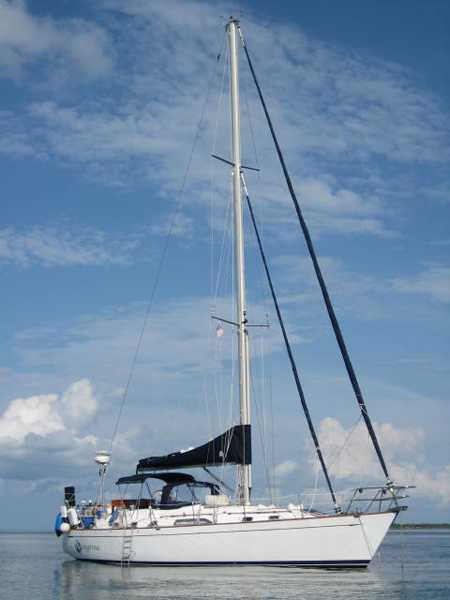
Let
me tell you how we attempt to accomplish this task considering the fact that
the navigational charts are notoriously poor in this part of the world and
there are no up-to-date cruising guides
Factors Affecting our Selection for
an Anchorage
This
past year, we have been in Thailand, Peninsular Malaysia, Borneo, Malaysia and
the southern Philippines. The weather in this part of South East Asia is
determined by the direction of the wind and the time of year. Sometimes there’s not a puff of air and other
times it can “blow like stink.” It can
be hot and dry or rainy and wet depending on whether you are sailing in what’s
known as the northeast monsoon season or the southwest monsoon season. No matter which way you approach it, anything
defined by the phrase “monsoon season” elicits a certain amount of dread…and no
more so than when you decide to put down the anchor.
We
usually look for any land masses, or islands, which could offer protection from
the prevailing winds. We like to ease
our way in as close as we can to the leeward side of a landmass out of harms’
way.
The
next determination is to look at the depth of the water. Does the depth go from 150 feet to 10 feet quickly
or is there a gradually shoaling which will allow us to nose around a bit and
look for a good spot. (As I said, the
charts here are somewhat unreliable in terms of accuracy so we take chart depths with a grain of salt and always use our best judgment and always choose
to ere on the side of caution.)
We
also have to consider the tides. Prior
to anchoring we want to have a good idea of what the tidal range is (how many
feet the tide rises and falls) and how much the tide will fall after the time
we anchor. Peregrina draws a bit over 6
feet at her keel and we want to be sure we have enough water below us so that we don't go bump in the night.
We
try to plan our passages to arrive at our destination before 3pm when we can
usually see the bottom clearly. After
this time, the low sun angle on the water causes the water to sparkle which
limits our ability to see the bottom. As the afternoon advances further, toward
evening, the water becomes too dark to
see what lurks below the surface.
As
we begin to feel our way into a new anchorage, we look at several things.
-Is
the water calm or is there a large “swell” rolling in? This will make cooking,
eating and sleeping very difficult.
-Is
there a sandy beach which may extend into the water? Sand makes for good anchoring.
-Is
the shoreline rocky? Rocks usually indicate poor holding.
-Does
the wind blowing across the anchorage show any change in patterns on the
surface of the water which might mean shallow spots or rocks?
As
we go into the anchorage, I am at the
helm. I
am looking at the depth sounder to see if the numbers change smoothly, which
means a bottom which could be relatively flat. If the numbers jump around, it may mean large rock or coral heads known as “bommies” are just below the surface.
Margie
is on the bow and she is looking for changes in water color (dark =
coral/thick grass/rock) or other obstructions and pointing them out to me.
Once
we agree on a location we often will make a circle around the desired anchoring
spot to examine the radius of our swing from the center point. More than once
taking the extra time to do this has allowed us to see a potential problem.
Anchoring – The “short snub” test
Once
we agree on the spot, I point the bow into the wind. When the boat stops moving
forward Margie “drops the hook.” With
the motor in neutral we drift backwards. When the amount of anchor chain out is
about the water depth plus about 60 feet we do a “short set” which tests the
holding power of the anchor on the bottom.
To do this Margie puts a “short snub” on the anchor which means she
attaches the snubber hook to the chain close to the windlass. She then pays out
a foot of chain. This connects the chain to the boat without the windlass.
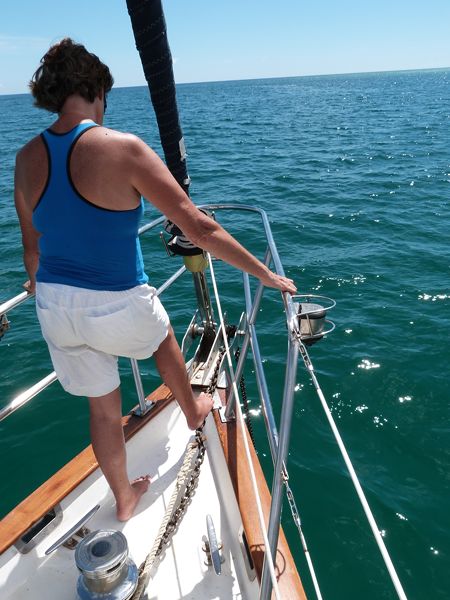
The
reason she does this is so when I put the boat into reverse, to test the
anchor’s attachment to the bottom, that
any jerks or tension on the chain will not damage the windlass. The other
reason for a “short set” on the snubber is to allow Margie to put her foot
directly on the anchor chain to feel whether it is bouncing along the bottom or holding firmly.
 When
Margie is ready she gives me the signal for “reverse” which is the thumb down. I put Hercules, our trusty diesel into reverse.
When
Margie is ready she gives me the signal for “reverse” which is the thumb down. I put Hercules, our trusty diesel into reverse.

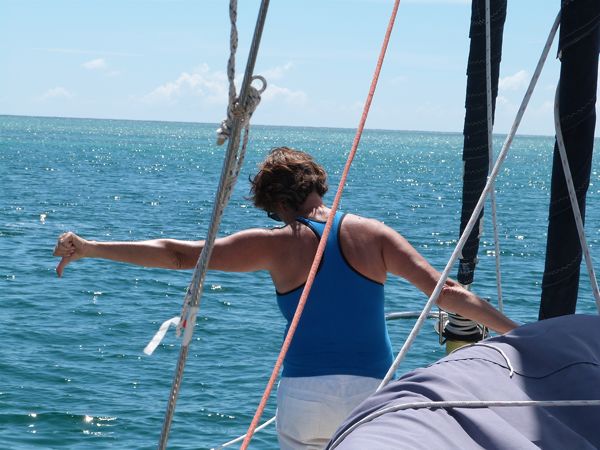
As
the anchor is pulled backwards it’s contact with the bottom is translated up
the chain and Margie can feel it on her foot.
If the bottom is full of small coral the chain will vibrate. If the
bottom has rocks the anchor may pull tight and then jump to another rock. With a smooth sandy bottom the anchor will
slide for a while and then dig in.
Once
Margie is satisfied that the anchor has set she gives me the "thumbs up" signal.
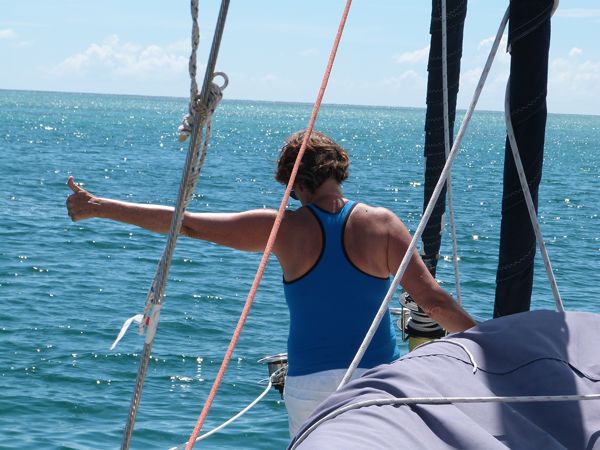
I
will then increase the engine rpm to above 10,000 to see if the anchor holds
well. If her thumb remains up the anchor is set and we are ready for the long
snub.
Full Snub Anchoring
Once
the anchor is set well we then decide how much scope (or chain) to let out.
Several factors enter into this decision. If there is a strong wind and waves
we let out more. If we are in a really protected area (e.g. a river or enclosed
harbor we may let out less). In general we adhere to the nautical wisdom that
says, "You have already paid for the chain so why keep it in the locker? Why not make sure it is doing its' job on the bottom holding you secure?” I like to have a minimum of twice
the boat length (about a hundred feet) on the bottom not including the chain
required to get to the bottom. Often we will have more.
With
the chain let out Margie will set up the full snub. For our snubber we chose
three strand line which stretches. The purpose of the snubber is three fold:
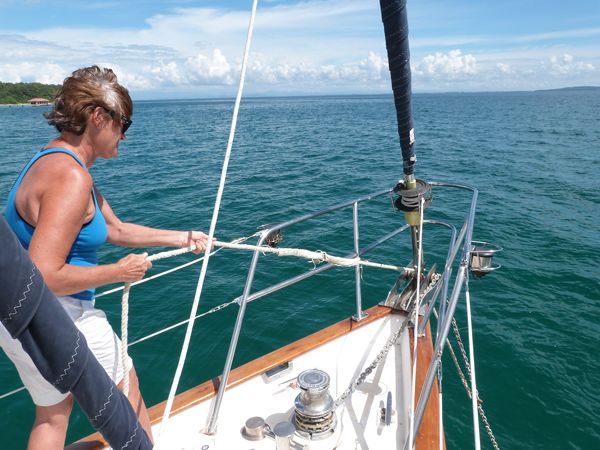
-Lower
the point of attachment of the boat to decrease the angle of pull

-Provide
a more flexible attachment which will not transmit shock back to the boat
-Not
use the valuable winch to absorb the pulling which could damage the winch.
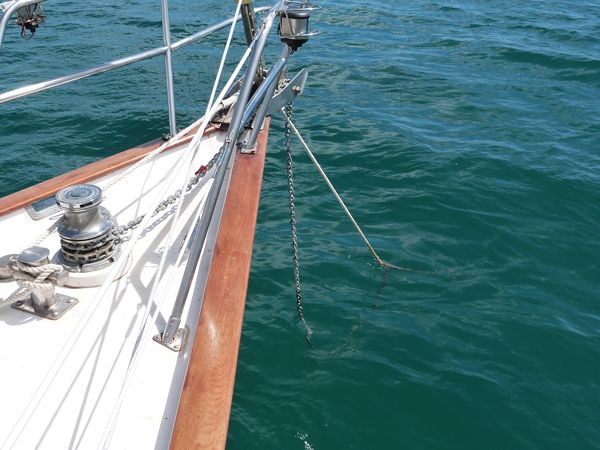

Our
snubber is about 17 feet long and we attach it to a strong samsons post on the
deck and not to the small deck cleats.
Escape Plan
Once the anchor is set we place an anchor waypoint in the GPS and
gather visual range marks on shore so that we can look out and judge whether we
have dragged anchor during the night. Our last task is to determine our “Escape
Plan” which is generally a simple compass heading to steer if we need to get
back out to sea at night. We use a compass heading since the compass works 24
hours a day and we do not have to wait valuable minutes for the electronic
package to warm up and begin generating GPS fixes and charts. Some times we
have had to leave anchorages quickly in the middle of the night.
Anchors A Weigh
To
lift the anchor Margie stands at the bow and gives me hand signals. One is the
direction of the anchor chain indicating which way I need to steer Peregrina. A
balled fist indicates that she wants me to put the engine in neutral. If the
anchor is stuck we may put on a “short snub” and use the engine to break it
free.
Anchoring is full of surprises.
Recently
in the Gaya Island, while using the short sub Margie determined that the anchor
was not holding. We raised the anchor and look what we found. Having plastic covering the ends of the Bruce anchor prevent the anchor from "biting" or sinking into the bottom.
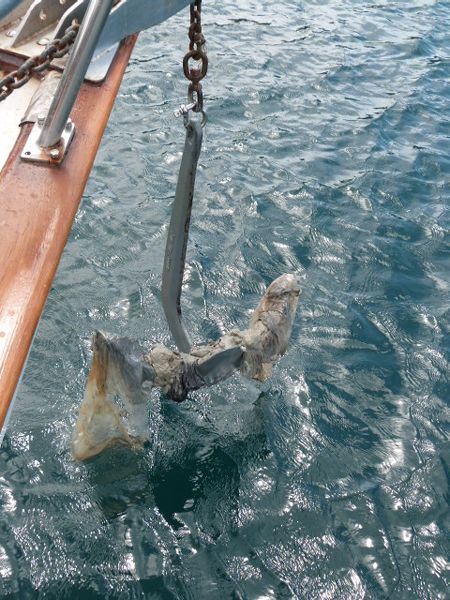
We
tried again and still were dragging so we raised the anchor a second time. It just got worse.
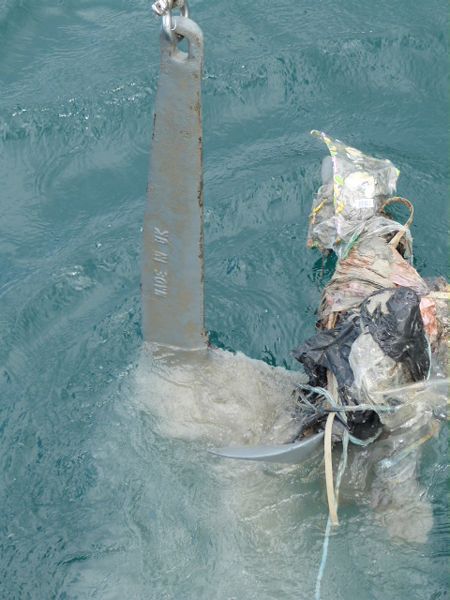
On
the third attempt Peregrina held super fast, even when I raised the rpms to 1,500. We
knew we were not going anywhere and could sleep well.
In
the morning we found out why we had held so well. We had apparently hooked the
remains of a large mooring rope which was still attached to the bottom.
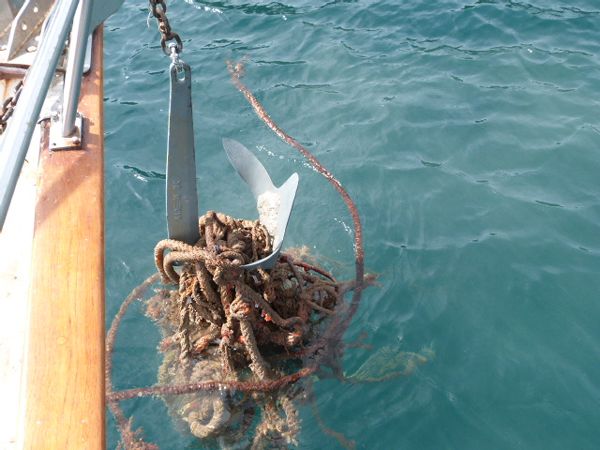
Unfortunately
the rope was too big for a boat hook to move so it was into the water for
Peter.

The
trick is to take the tension off the mess on the anchor so Peter led a rope
from the bow down, through the tangled rope and back up to the bow. Margie then
dropped the anchor about three feet which took the pressure off the anchor so
that Peter could free it from the anchor using his hands and kicking with his feet. Once the
tangled mess was away from the anchor one end of the rope on the boat was
slackened and the mess drifted down into the briny deep.
Anchoring is probably the aspect of cruising that gives us the most Pepto Bismol moments and, now, you know why!
----------------------------------------